Introduction
Many naturally occurring or man-made radioactive isotopes have the property of radioactivity, which is the spontaneous decay of unstable nuclei. This phenomenon occurs in materials found in the ground, air, water, the human body, and everything that contains radioactive elements 1. Humans are constantly exposed to many forms of radiation, including alpha and beta particles and gamma rays, due to the presence of radioactive elements in our environment. This radiation exposure is a natural occurrence that is an inherent part of our everyday lives. Radioactive elements of natural origin are present in soil, water, plants, petroleum, phosphates, most ores, animals, and people 2. In the era of the first discoveries of radioactivity, scientists did not know the dangers of this radiation, which led to a number of these scientists contracting cancer 3. Then, the topic of radiation protection began to develop, especially after understanding the effect resulting from exposure to ionizing radiation. Radioactive pollution is one of the most important and dangerous environmental problems, as it represents increasing dangers that threaten the lives of humans, animals, and plants alike due to the widespread use of (radioactivity) materials with radioactivity and their abundance in various fields of life. This type of pollution results from the presence of concentrations of radionuclides that were not originally present in the environment, or an increase in the concentrations present (radionuclide) of them in the environment. The food chain is a crucial pathway for the rapid transmission of radioactive pollutants. Various organisms in the food chain become contaminated with radioactive materials, such as plants, animals, and their products, leading to an increase in the percentage of contamination 4,5. Radioactive materials may enter the water and food system due to human use of these substances for peaceful reasons. And devoid of any military involvement. Throughout the Second Gulf War in 1991 and the subsequent occupation of Iraq in 2003, the environment in Iraq, particularly in the southern area, was subjected to a novel kind of radioactive weaponry known as depleted uranium bullets. Consequently, there was a growing need to quantify the level of activity in Depleted Uranium projectiles. Radiation interacts with environmental components to assess the level of harm caused by the use of items possessing hazardous radioactivity. The presence of natural radioactivity in food, especially food consumed by children, is due to the radioactive isotopes uranium-238, thorium-232, and potassium-40 6-8. Environmental radioactivity and the associated external exposure to gamma radiation primarily vary based on geological and geographical factors, resulting in varying soil levels throughout various regions of the globe 9. External exposure means that the exposure is outside the body, meaning that it results from natural nuclides present in the environment, but internal exposure is that which occurs inside the body through nutrition and breathing. There are several studies on the subject of natural radioactivity in foodstuffs, the most important of which is the study that was held at the Radiation Protection Center in the Ministry of the Environment for various foodstuffs. This study focused on measuring the natural radioactivity of samples of milk, rice, sugar and other materials. This study proved that radioactivity naturally, the measured foodstuffs contain the radioactive element potassium-40, but within the internationally permissible limits 9. In Iraq, there is no database of natural radioactivity in food to which all humans, especially children, are exposed. Therefore, this research aims to study the levels of natural radioactivity in samples of children food available in local markets by measuring the relative radioactivity of potassium (40K), uranium (238U), and thorium (232Th) as well as, comparing it to the level of global radioactivity. Also, this study can compare the results with the recommended international values for safety standards.
Collecting of Samples
The samples used in this study were collected from Iraqi local markets, where the samples included 13 types of foods used by children and from different origins, most of which are imported, as listed in Table (1). Samples were collected in January 2024.
Table 1: Samples of children foods used in the research.
|
Type of foodstuff |
Sample code | Country |
|
Biscuit |
B1 |
Iran |
| B2 |
Iran |
|
| B3 |
Iraq (Zago) |
|
|
Cocoa powder |
B4 | Iraq (Erbil) |
| B5 |
Iraq (Kerbala) |
|
|
Milk |
B6 |
UAE |
|
B7 |
Holand |
|
| B8 |
Iraq (Erbil) |
|
|
Indomie |
B9 |
Turkey |
|
B10 |
Saudia |
|
| B11 |
Saudia |
|
|
Soup |
B12 |
Turkey |
| B13 |
Saudia |
Preparation Samples
Thirteen children’s food samples from various local and imported origins available in Iraqi markets were collected and then transported to the Nuclear and Radiation Physics Laboratory located in the Department of Physics at the Faculty of Science at the University of Kufa to prepare them for practical measurements by heating them using an electric oven and then grinding them. The electric grinder was fine to obtain a homogeneous material, and then its weight was measured using a sensitive balance, and most samples weighed about 0.75 kg. Samples were placed in plastic cups (Marinelli Baker) made of polyethylene to ensure geometric uniformity around the detector.
Detection and Measurement System
The parts of the system were connected, where the detector was connected to the calculator via a connection cable, and the gamma ray spectrum was then recorded using the MESTRO-32 program. The radiometric measurements were conducted using an ORTEC gamma spectrometer, namely the model 931000. This spectrometer is equipped with a NaI(Tl) detector provided by Alpha Spectra, Inc.-12I12/3. The detector has a crystal size of (3×3) angstroms. Additionally, the spectrometer has an analyzer. The Multi-channel Analyzer (MCA) is composed of 4096 channels and includes a digital converter (ADC) for power discrimination based on the Full Width at Half Maximum (FWHM). At the highest point, we utilize a 60Co source emitting radiation with an energy of 1.33 (keV), and the discrimination value is 7.9%. A specific shield was employed to decrease background radiation, comprising two layers: the first layer made of stainless steel with a thickness of 10 mm, and the second layer made of lead with a thickness of 30 mm. The specimen was positioned at the center of the room, protected by a shield, for about 5 hours. Subsequently, the levels of radioactivity from isotopes 40K, 238U, and 232Th were assessed using the (EC & ORTEC) software. The particular activity of 238U was found by measuring the energy of 1764.49 keV emitted during the decay of 214Bi, which has a known specific activity. The disintegration rate of 232Th at an energy of 2614 keV is 15.96%. This is based on the particular activity of the 208Tl nuclide, which has a dissolution probability of 99%. The effectiveness of 40K at an energy of 1460 keV, with a dissolution probability of 11%, is also determined [8,10].
Calculation
Considering that the specific activity of all elements of the radioactive series is in a state of squalor equilibrium, it is therefore possible to calculate the concentration of one element in this series in terms of the concentration of another element [6,7]. The specific activity can be calculated through the following equation 11, 12:
where, : The area under the curve of the photo peak, : The calculated efficiency of the detector, : Model mass (Kg), and : Measurement time.
Results
Table (2) displays the outcomes of the specific activity of the naturally occurring radioactive elements found in the food additives being examined. Table (2) and Figure (1) display the particular activity values for potassium-40, whereas Table (2) and Figure (2) present the specific activity values for uranium-238. Figure 4, along with Table 2, displays the specific activity levels of thorium in thirteen food samples (measured in Bq/kg) obtained from Iraqi markets in the current investigation. Based on Figure (1), it is seen that the specific activity of potassium-40 varies between 52.11 Bq/kg and 619.61 Bq/kg. Based on Figure (2), we see that the specific activity of uranium-238 varied between (4.11) Bq/kg and (18.9) Bq/kg. Furthermore, based on Figure (3), it is seen that the specific activity of thorium-232 varies between (0.39) Bq/kg and (12.06) Bq/kg.
Table 2: Results of the specific activity of the elements potassium-40, uranium-238, and thorium-232 in the samples under study.
|
Sample code |
Type food | Specific activity (Bq/kg) | ||
| K-40 | U-238 | Th-232 | ||
|
B1 |
Biscuit | 79.45 | 7.71 | 2.03 |
|
B2 |
52.11 | 11.5 |
2.54 |
|
| B3 | 136.44 | 12.01 |
1.1 |
|
|
B4 |
Cocoa powder | 459.78 | 15.53 | 3.5 |
| B5 | 619.61 | 15.89 |
12.06 |
|
|
B6 |
Milk powder | 183.18 | 18.9 | 3 |
|
B7 |
173.01 |
11.75 |
3.65 |
|
| B8 | 414.67 | 9.23 |
0.39 |
|
|
B9 |
Indomie | 113.63 | 11.97 | 1.32 |
|
B10 |
161.25 |
4.11 |
0.8 |
|
| B11 | 52.82 | 10.28 |
0.56 |
|
|
B12 |
soup | 101.58 | 15.27 | 2.72 |
| B13 | 219.66 | 7.02 |
2.43 |
|
|
Internationally permissible limits [13] |
420 | 35 |
45 |
|
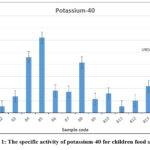 |
Figure 1: The specific activity of potassium-40 for children food samples. |
 |
Figure 2: The specific activity of uranium-238 in children food samples. |
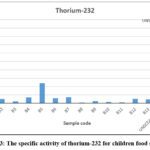 |
Figure 3: The specific activity of thorium-232 for children food samples. |
Discussion
The specific activity of potassium-40, uranium-238, and thorium-232 was analyzed, revealing that form (B5) had the greatest specific activity for potassium-40, measuring 61.619 Bq/kg. Conversely, form (B2) had the lowest specific activity for potassium-40, measuring 4.11 Bq/kg. Thus, it can be concluded that all models have a potassium-40 activity level that falls below the internationally accepted limit set by UNSCEAR (2008) of 420 Bq/kg 13, except for the cocoa models B4 and B5.
The study revealed that the uranium-238 form with the greatest specific activity, denoted as (B5), had a value of 15.89 Bq/kg. Conversely, the form with the lowest specific activity denoted as (B10), had a value of 4.11 Bq/kg. All samples examined were confirmed to be below the internationally permissible limit. According to the UNSCEAR (2008) report, the value is 35 Bq/kg 13.
The study revealed that thorium-232 exhibited the maximum specific activity in the form (B5), with a value of 12.06 Bq/kg, while the lowest value was seen in the form (B8), with a value of 0.39. It was determined that the specific activity levels for thorium-232 in all samples were below the globally accepted limit set by UNSCEAR (2008), which is 45 Bq/kg 13.
Based on the findings shown in Table (2), it was observed that there are notable variations in the activity levels of all samples of children’s food obtained in local markets. This may be related to the geological makeup of the regions where the food is cultivated. The uranium element has more activity than thorium in all samples, as seen by the average uranium levels. Furthermore, it should be emphasized that the activity of 40K surpasses the values of both 238U and 232Th, making it the most prevalent radioactive element under consideration.
Figures (4), (5), and (6) show comparisons of the specific activity of the isotopes (potassium-40, uranium-238, and thorium-232), respectively, under study for the various foods used in the current study.
From Figure (4), we found that the highest concentration of potassium-40 for cocoa powder samples is higher than the internationally permissible value. This can be attributed to several reasons, the most important of which is the geological nature of the soil in which the plant is grown and the excessive use of chemical fertilizers that contain the element potassium-40 in a high percentage [14]. Plant components also have an effect, as cocoa seeds contain magnesium, copper, iron, phosphorus, calcium, potassium, vitamin A, vitamin C, vitamin D, and others.
Also, from Figures (5) and (6), we found that the highest concentration of uranium-238 and thorium-232 was in the cocoa powder samples, noting that the highest value was much less than the internationally permissible limits.
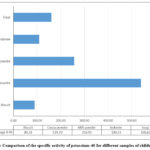 |
Figure 4: Comparison of the specific activity of potassium-40 for different samples of children food. |
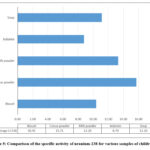 |
Figure 5: Comparison of the specific activity of uranium-238 for various samples of children food. |
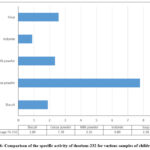 |
Figure 6: Comparison of the specific activity of thorium-232 for various samples of children food. |
Finally, the results value of natural radioactivity (238U, 232Th, and 40K) and radiological parameters due to these in children’s foods in the present study were safe,
Conclusion
The children food samples studied in the work contain natural radioactivity. The specific activity of potassium-40 for all studied samples was less than internationally permissible limits, except for the cocoa samples. The specific activity of uranium-238 for all models is less than what is internationally permitted. The specific activity of thorium-232 is also less than what is internationally permitted. Most of the studied models of children food available in various Iraqi markets are of edible origin and only from a radiological perspective. To protect food and Public health from natural radioactivity, there are many recommendations introduced to the responsible authorities, such as forming a specialized work team to conduct radioactivity in other samples of food, reducing the use of chemical fertilizers, which are used especially in agricultural areas, and creating a database of natural radioactivity in food that commonly found in Iraqi markets.
Acknowledgement
The author would like to thank, (Insert university name and Dept. name) for their guidance and support to complete this article.
Funding Sources
The author(s) received no financial support for the research, authorship, and/or publication of the article.
Conflicts of Interest
There are no conflicts of interest.
Data Availability Statement
Data generated or analyzed during this study are included in this published article.
Author Contribution Statement
Each author subscribes to conceiving and designing the analysis; Collected the data; Contributing data or analysis tools; Performed the analysis; Writing the paper.
References
- Magill, J., & Galy, J. (2014). Radioactivity Radionuclides Radiation (2005th ed.). Berlin, Germany: Springer.
- L’Annunziata, M. F. (2022). Radioactivity: History, science, vital uses and ominous peril (3rd ed.). Philadelphia, PA: Elsevier – Health Sciences Division.
- Grupen, C., & Rodgers, M. (2018). Radioactivity and radiation: What they are, what they do, and how to harness them. Cham, Switzerland: Springer International Publishing.
- Vosniakos, F. K. (2014). Radioactivity transfer in environment and food (2012th ed.). Berlin, Germany: Springer.
CrossRef - Alkufi, A. A., Kadhim, S. A., & Alhous, S. F. (2022, August). Comparison of excess lifetime cancer risk for different age groups for selected flour samples. In AIP Conference Proceedings (Vol. 2437, No. 1). AIP Publishing.
CrossRef - Abojassim, A. A., Dahir, D. M., Alaboodi, A. S., & Abonasria, A. H. (2016). Annual effective dose of gamma emitters in adults and children for some types of rice consumed in Iraq. Journal of Food Protection, 79(12), 2174–2178. doi:10.4315/0362-028x.jfp-16-242
CrossRef - Ahmed, A. Q., Mohsen, A. A. H., Al-Khayyat, A. N., Abojassim, A. A., & Munim, R. R. (2019). Natural radioactivity in cerelac baby food samples commonly used in Iraq. Plant Archives, 19(1), 1057-1061.
- Mahdi, F. A., Majeed, F. A., & Salih, N. A. (2023). Natural radioactivity in common biscuits samples in Iraq. Journal of Population Therapeutics and Clinical Pharmacology, 30(4), 431-437.
CrossRef - Heikal, M. T. (2023). Environmental natural radioactivity. LAP Lambert Academic Publishing.
- Hamzah, Z. S., Hashim, A. K., & Abojassim, A. A. (2022). Assessment of Annual Effective Dose and Excess Lifetime Cancer Risk in Grain Samples Collected from Kerbala Governorate, Iraq. Iranian Journal of Science and Technology, Transactions A: Science, 1-10.
CrossRef - Abojassim, A. A., Hady, H. N., & Mohammed, Z. B. (2016). Natural radioactivity levels in some vegetables and fruits commonly used in Najaf Governorate, Iraq. Journal of bioenergy and food science, 3(3), 113-123.
CrossRef - Aswood, M. S., Abojassim, A. A., & Al Musawi, M. S. A. (2019). Natural radioactivity measurements of frozen red meat samples consumed in Iraq. Radiation Detection Technology and Methods, 3(4), 1-4.
CrossRef - United Nations. (2011). Sources and effects of ionizing radiation: UNSCEAR 2008 report, volume 2, effects, scientific annexes C, D and E. New York, NY: United Nations.
- Ibikunle, S. B. (2023). Assessment of natural radioactivity of some food samples commonly consumed in Nigeria and its radiological impact. International Journal of Environmental Science and Technology, 20(3), 3085-3090.
CrossRef

This work is licensed under a Creative Commons Attribution 4.0 International License.





